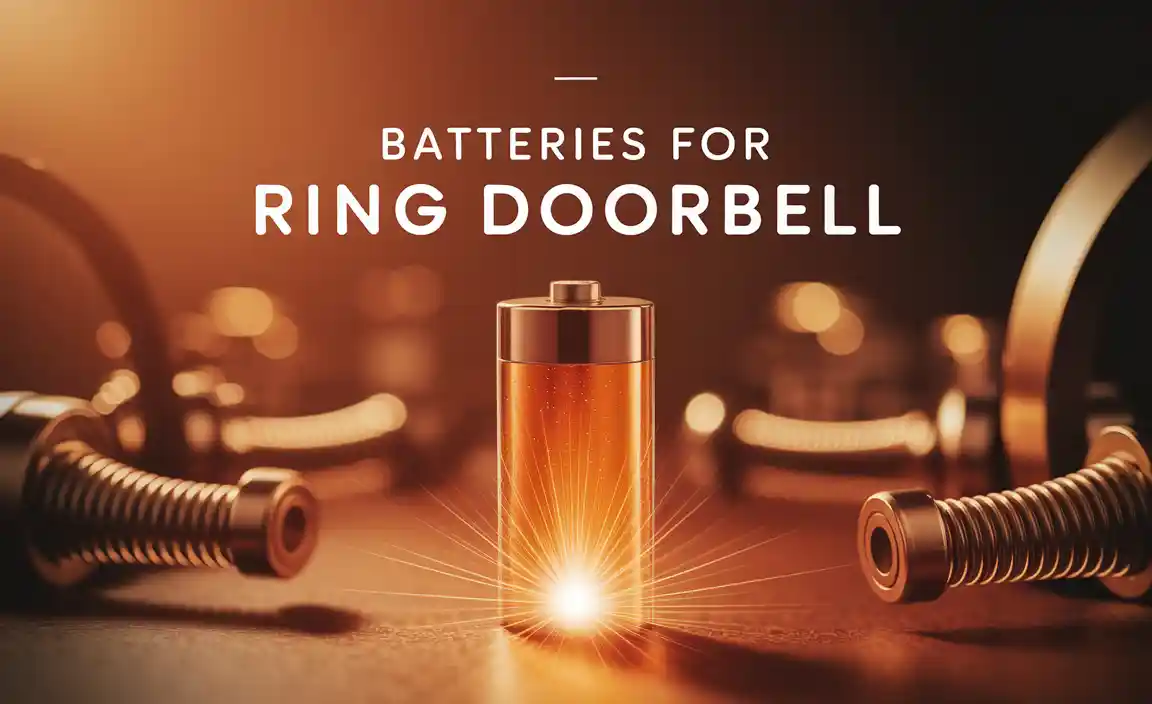The correct battery for your 2013 Kia Optima is a priority for reliable starting and power. Typically, you’ll need a Group Size 24F or 35 battery with good Cold Cranking Amps (CCA) for our climate. Replacing it is a manageable DIY task with the right tools and safety steps.
Is your 2013 Kia Optima acting sluggish? Sometimes, it’s the battery! Car batteries don’t last forever, and knowing when yours needs attention can save you from frustrating breakdowns. We’ve all been there – turning the key and hearing that weak click, or worse, nothing at all. It’s a common car problem, but totally fixable.
This guide is here to make understanding and even replacing your 2013 Kia Optima’s battery simple. We’ll walk through identifying the right battery, when to consider a replacement, and how to do it yourself safely. You’ll be back on the road with confidence in no time! Let’s get your Optima powered up.
Understanding Your 2013 Kia Optima Battery
Your car battery is the heart of your vehicle’s electrical system. It does the vital job of starting the engine, and then it powers all the accessories like your lights, radio, and windows when the engine isn’t running. For a 2013 Kia Optima, selecting the right battery is key to its smooth operation.
What Makes a Battery “Right” for Your 2013 Kia Optima?
When looking for a battery, you’ll see terms like “Group Size,” “CCA,” and “Reserve Capacity.” These might sound technical, but they’re important indicators of a battery’s performance and compatibility.
Group Size: This is a standardized measurement that tells you the physical dimensions of the battery and how its terminals are positioned. Think of it like a shoe size; your Optima needs the right fit. For most 2013 Kia Optimas, you’ll be looking at Group Size 24F or sometimes Group Size 35. Always double-check your owner’s manual or consult a reputable auto parts store for the exact recommendation for your specific trim level. The “F” in 24F indicates a specific terminal arrangement, which is important for correct connections.
Cold Cranking Amps (CCA): This rating tells you how much power the battery can deliver to start your engine in freezing temperatures. The higher the CCA, the better it is for starting in colder climates. For the 2013 Kia Optima, a CCA rating of at least 500-600 amps is generally recommended. More is usually better if you live where it gets very cold.
Reserve Capacity (RC): This measures how long the battery can provide power if your alternator fails. It’s a good indicator of how long your lights and other accessories could run on battery power alone. A higher RC is always a plus, offering extra peace of mind.
Types of Batteries for Your Optima
While most 2013 Kia Optimas use traditional lead-acid batteries, sometimes hybrid models might have specific requirements.
Standard Flooded Lead-Acid Batteries: These are the most common and cost-effective. They work well for most standard driving needs.
Absorbent Glass Mat (AGM) Batteries: These are a more advanced type, offering better performance, longer life, and improved vibration resistance. If your Optima has a lot of features that draw power or if you live in a very harsh climate, an AGM battery might be a worthwhile upgrade. They also tend to be spill-proof.
Hybrid Specific Batteries: For a battery for 2013 Kia Optima Hybrid, it’s crucial to confirm if it requires a specialized hybrid battery system component distinct from the standard “12-volt” battery. Often, hybrid vehicles have a separate, larger battery pack for propulsion. However, they still rely on a standard 12-volt battery to start the internal combustion engine and power accessories. Always verify the specific type needed for your hybrid model, as it can differ from the gasoline version.
When to Replace Your 2013 Kia Optima Battery
Batteries typically last between 3 to 5 years. However, several signs might indicate it’s time for a replacement sooner rather than later. Paying attention to these warnings can prevent you from getting stranded.
Common Warning Signs of a Failing Battery
Slow Engine Crank: This is the most classic sign. When you turn the key, if the engine cranks slower than usual, it means the battery isn’t delivering enough juice.
Clicking Sound When Starting: If you hear a rapid clicking noise when trying to start your car, it often means the battery is too weak to engage the starter motor properly.
Dim Headlights or Interior Lights: If your lights seem dimmer than usual, especially when the engine is off or idling, the battery’s charge is likely low.
Electrical Issues: Unexpected problems with your car’s electronics, like the radio cutting out, power windows moving slowly, or dashboard warning lights flickering, can also point to a weak battery.
Worn or Corroded Terminals: Look at the metal posts where the battery cables connect. If you see a white or bluish powdery substance (corrosion), it can hinder the battery’s ability to get a good charge or deliver power.
Sulfuric Odor: A rotten egg smell near the battery can indicate that it’s overheating or leaking, which is a serious issue.
Battery Warning Light: Your dashboard might illuminate a battery-shaped warning light. This can mean a variety of things related to the charging system, but a dying battery is a common culprit.
Age: If your battery is over 3-4 years old, even if it’s performing okay, it’s wise to consider proactive replacement, especially if you live in extreme weather conditions.
Testing Your 2013 Kia Optima Battery
You can get your battery tested for free at most auto parts stores. They have specialized testers that measure the battery’s voltage and CCA output. If you prefer to test it yourself, you’ll need a multimeter.
Multimeter Test:
1. Ensure the engine is off and has been for at least a few hours for an accurate static reading.
2. Set your multimeter to DC Volts (VDC), usually the setting with a “V” and a straight line above a dashed line.
3. Place the red (positive) probe on the positive (+) battery terminal and the black (negative) probe on the negative (-) terminal.
4. A fully charged battery should read around 12.6 volts or higher.
5. If the reading is 12.4 volts or lower, the battery may be discharged or failing.
6. To test under load (seeing how it performs when starting), you’ll need a more advanced battery load tester, which is what auto parts stores use and is safer for beginners.
Choosing the Right Battery Part Number
Let’s get specific about finding the perfect battery for your 2013 Kia Optima. This is where precision matters.
Where to Find Your Optima’s Battery Information
1. Owner’s Manual: This is your definitive source. Look in the maintenance or specifications section. It will list the recommended battery group size and CCA.
2. Battery Tray/Hood: Sometimes, the correct group size is printed on a sticker on the battery itself or on the frame under the hood.
3. Online Retailers & Auto Parts Stores: Websites like AutoZone, Advance Auto Parts, O’Reilly Auto Parts, or even Amazon’s automotive section have tools where you enter your car’s year, make, model, and engine size, and they’ll show you compatible batteries.
4. Consult a Professional: If in doubt, visit a local mechanic or battery specialist.
Example Battery Specifications Table
Here’s a general idea of what you might find. Note that specific requirements can vary slightly by engine size (e.g., 2.4L vs. 2.0L Turbo) or trim.
| Battery Feature | Recommendation for 2013 Kia Optima (General) | Notes for Hybrid Model |
| :—————– | :—————————————– | :———————————————————————————————————————————————————————————————————————————————————————————————————————————————————————————— |
| Group Size | 24F or 35 | Crucially Important: For a battery for 2013 Kia Optima Hybrid, the 12-volt battery for accessories and starting is often a different group size than the gasoline model. Verify your hybrid owner’s manual or consult a specialist. It might be a smaller size or a specialized type. The main hybrid propulsion battery is entirely separate and not a DIY replacement item. |
| CCA (Cold Cranking Amps) | 500 – 650+ | Higher CCA is better for cold climates. If you live in a region with frequent sub-freezing temperatures, aim for the higher end of this range or even more. |
| Voltage | 12 Volts | Standard for virtually all cars. |
| Terminal Type | Top Post | Most common, but ensure it matches your existing cables. Group Size 24F has specific terminal placement that is different from a standard 24 or 35. |
| W x L x H (Approximate) | Varies by Group Size | Group 35: ~7″ x 7″ x 7″. Group 24F: ~10.7″ x 7″ x 8.2″. Physical dimensions are critical for fitment. |
| Warranty | 2-4 Years | Longer warranty often means better build quality. Look for free replacement policies. |
DIY Battery Replacement: A Step-by-Step Guide
Replacing your 2013 Kia Optima’s battery is a common DIY job that can save you money. Let’s go through the process safely.
Safety First!
Car batteries contain corrosive acid and can produce explosive hydrogen gas. Always prioritize safety:
Always wear safety glasses and gloves.
Work in a well-ventilated area, away from sparks or open flames.
Ensure the ignition is OFF and the key is removed.
Make sure your vehicle is parked on a level surface and the parking brake is engaged.
Never allow metal tools to touch both battery terminals at the same time, or to touch a terminal and the car’s metal frame – this can cause a short circuit and sparks.
Disconnect the negative terminal first, and reconnect it last. This prevents accidental shorting.
Tools You’ll Need
Safety Glasses
Work Gloves (preferably rubber or nitrile)
Wrench Set or Socket Set: You’ll likely need a 10mm or 13mm wrench or socket for battery terminal clamps and hold-down brackets. Check your specific vehicle.
Wire Brush or Battery Terminal Cleaner: For cleaning corrosion off terminals and cable clamps.
Battery Carrier (Optional but Recommended): Makes lifting and carrying the heavy battery easier and safer.
Rag or Paper Towels: For cleaning up.
Anti-Corrosion Spray or Dielectric Grease (Optional): To protect terminals after installation.
The Replacement Process
Here’s how to swap out your old battery for a fresh one:
- Locate the Battery: Pop the hood of your 2013 Kia Optima. The battery is typically located on the passenger side of the engine compartment.
- Identify Terminals: Locate the positive (+) and negative (-) terminals. The positive terminal usually has a red cover or is marked with a “+”. The negative terminal is marked with a “-“.
- Disconnect the Negative Cable FIRST: Use your wrench to loosen the nut on the clamp holding the negative (-) cable to the battery terminal. Wiggle the clamp gently to remove it from the terminal. Move the cable aside so it cannot accidentally touch the battery terminal again.
- Disconnect the Positive Cable: Now, loosen the nut on the clamp holding the positive (+) cable to the battery terminal. Wiggle it off and move it aside, ensuring it doesn’t touch any metal on the car.
- Remove the Hold-Down Bracket: Most batteries are secured by a bracket at the base or top. You’ll need to use a socket wrench to remove the bolts or nuts holding this bracket in place. Keep these parts safe; you’ll need them for the new battery.
- Remove the Old Battery: With the cables disconnected and hold-down removed, you can now carefully lift the old battery straight up and out of its tray. Batteries are heavy, so use caution to avoid back strain. A battery carrier can be very helpful here.
- Clean the Battery Tray and Terminals: Before installing the new battery, inspect the battery tray for any debris or corrosion. Use your wire brush to thoroughly clean the inside of the cable clamps (both positive and negative). Clean any corrosion off the battery terminals on the new battery as well. A clean connection ensures good power flow. For more on battery care and maintenance, resources like the U.S. Department of Energy offer valuable insights into keeping your vehicle’s power systems healthy.
- Install the New Battery: Carefully place the new battery into the tray, making sure it’s oriented correctly (positive terminal facing the positive cable, negative terminal facing the negative cable). Ensure it sits firmly and squarely.
- Reinstall the Hold-Down Bracket: Secure the new battery in place using the original hold-down bracket and bolts. Make sure it’s snug but don’t overtighten, as this could crack the battery case.
- Connect the Positive Cable FIRST: Place the positive (+) cable clamp onto the positive terminal of the new battery. Tighten the nut securely with your wrench.
- Connect the Negative Cable LAST: Place the negative (-) cable clamp onto the negative terminal. Tighten the nut securely. You may see a few sparks when connecting the negative terminal, which is normal as the car’s electronics re-engage.
- Optional: Apply Anti-Corrosion Spray/Grease: Lightly spray the terminals with anti-corrosion spray or apply a thin layer of dielectric grease to help prevent future corrosion.
- Final Check: Ensure all connections are tight and the battery is secure. Close the hood.
- Test Your Car: Start your 2013 Kia Optima. It should start up promptly. Check that your headlights, radio, and other accessories are working normally. You might need to reset your car radio presets.
Battery Maintenance Tips for Longevity
Once you’ve got a fresh, reliable battery in your 2013 Kia Optima, a little care goes a long way to ensure it lasts as long as possible.
Keeping Your Battery in Top Shape
Regular Cleaning: Inspect the battery terminals and cable connections periodically. If you see any signs of corrosion, clean them off gently with a wire brush and a mixture of baking soda and water.
Check Hold-Downs: Ensure the battery is always securely fastened in its tray. A loose battery can vibrate excessively, shortening its lifespan and potentially causing damage.
Avoid Deep Discharges: Don’t leave accessories like lights or the radio on for extended periods with the engine off. If you do, make sure to recharge the battery afterward.
Short Trips: Frequent short trips where the engine doesn’t run long enough to fully recharge the battery can wear it down over time. If you frequently drive short distances, consider taking your Optima on a longer drive (30+ minutes) once a week.
Extreme Temperatures: Both extreme heat and cold can affect battery performance and lifespan. In very hot climates, ensure the battery area is well-ventilated. In very cold climates, make sure your battery has sufficient CCA for reliable starting. Using a trickle charger in winter can help maintain full charge.
Professional Testing: Even with good maintenance, have your battery tested annually, especially as it approaches the 3-year mark. Most auto parts stores offer this service for free.
Alternatives and Considerations
While DIY replacement is often straightforward, there are times when professional help or alternative solutions might be better.
When to Call a Professional
Unsure or Uncomfortable: If you’re not confident in performing the replacement yourself, it’s always best to take it to a qualified mechanic. Incorrect installation can damage your car’s electrical system.
Specialized Systems: If your 2013 Kia Optima has a particularly complex electrical system or if you have a hybrid model and are unsure about its specific battery requirements, professional advice is recommended.
Stuck or Corroded Parts: If battery terminals are severely corroded or seized, attempting to force them can cause damage. A mechanic has specialized tools to handle these situations.




